STEM Is Alive and Well
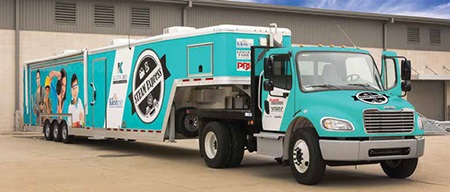
We’ve all seen the scary statistics. By 2018, there will be 1.2 million unfilled STEM jobs. Only 10 percent of US scientists and engineers come from underrepresented minority groups. In 2013, 35 percent of eighth-grade students performed at or above the proficient level in mathematics. But I’m here to tell you that when we started looking for schools offering STEM lessons and programs, we were inundated. So maybe we can turn these numbers around and STEM the tide? I’m counting on it.
In Texas, high-school freshmen choose an area of focus (e.g. STEM, public service, arts and humanities). Administrators at Klein (TX) Independent School District (KISD) wanted elementary-and middle-school kids to learn about different careers so they could make more informed decisions later on. That’s how the mobile station came about. “We already had a reading express; this was the ‘Big Brother’—a mobile lab with technology, art, and science equipment to do hands-on activities,” says Adam Hile, director of curriculum and instruction. The Education Foundation handled fundraising and worked with vendors, including CDW-G, to donate time and effort. All told, the STEAM Express cost around $425,000 of donated services and equipment from the community. The STEAM Express goes to all 42 of the district’s campuses as well as to community centers and events at parks and libraries.
Students enter the STEAM Express and explore each station to learn about careers. There are usually 30 students, and coordinator Bill Nebeker (aka “the mad scientist,” who travels with the STEAM Express) splits them into two groups to work together on age-appropriate activities. “I’m excited by their excitement,” says Nebeker. “I especially like when the older students ask, ‘What’s next?’ I want them to be as engaged as I would be.” Recently, a boy approached Nebeker in a restaurant and told him all the things he’d loved doing on the STEAM Express when he was on it seven months earlier. For Nebeker, that validation was magical.
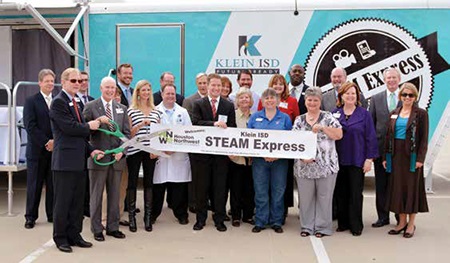
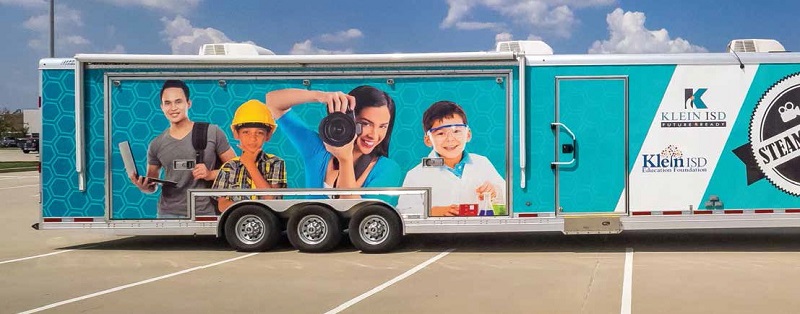
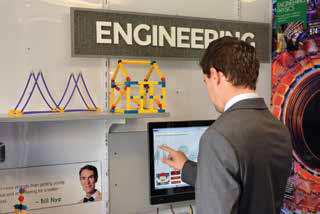
ENGINEERING
Students learn what electrical and other engineers do by building roller coasters (using Knex and other products). Then they test the coasters to see if they need to be taller or faster.
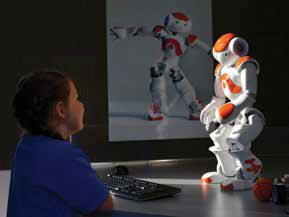
ROBOTICS
Sally and Leo are only two of the many robots that students can program in 22 different languages. They can also use Legos to build their own robots.
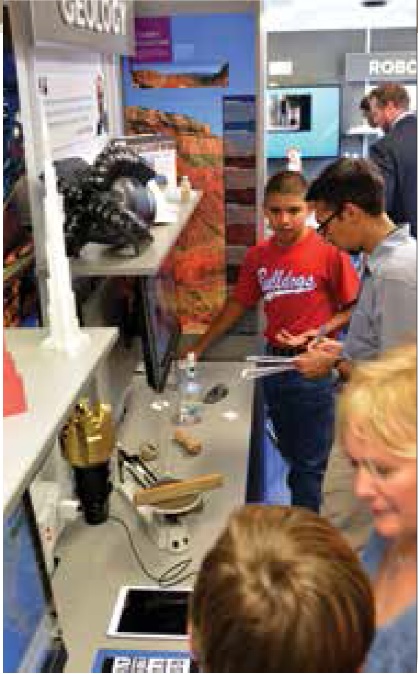
GEOLOGY
Using digital microscopes, kids look at rocks, minerals, and diamonds that have been crushed. They use a digital scale to see drill bits and learn about land drilling, which is a key industry in Houston.
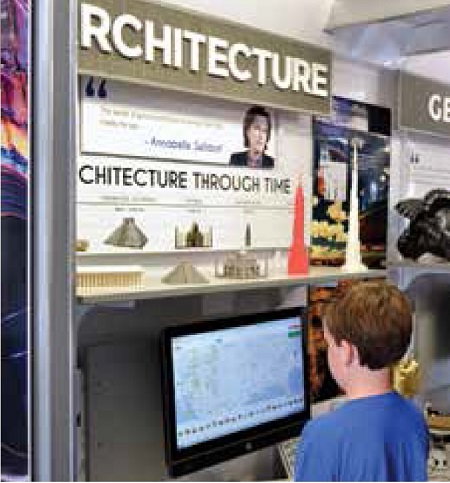
ARCHITECTURE
From 3D printers to the Lego Web site, students use math and art to create a home, make a floor plan, and learn about angles. The timeline shows items that have been built.
Tools and ideas to transform education. Sign up below.

The learning doesn’t stop when the STEAM Express pulls away. Nebeker hands out cards that list Web sites for future exploration (either in class or at home), and students can take the projects they’re building and continue to work on them. “Our goal is to make it more than a one-time experience,” says Hile. “What’s amazing is that a short visit can spark a lifetime of interest.”
Embrace Java
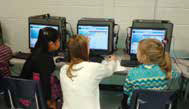
Last year, Alexandra Vlachakis’s high-school juniors in Fayette County (GA) Schools wrote lessons for Hour of Code and promoted them on Edmodo. “We wanted to give kids a chance to do actual Java coding, so we created videos to walk people through the lessons,” she says. Later, her students brought Java to 300 children at two elementary schools and were excited to see the young students so engaged with it. “It was a really fun activity to do with both age groups,” says Vlachakis, who ended up leaving the district to work for Code.org.
Hands-On Learning
When Richard Montgomery became superintendent of the Star City (AR) School District in 2011 and received a STEM Works grant, he used it toward curriculum from Project Lead the Way (PLTW). “We’ve introduced six of the eight gateway PLTW courses in our middle school, and our high school has engineering, biomedical science, and computer science,” he says. In 2013, the district piloted PLTW’s K–5 program that integrates hands-on STEM activities across the curriculum; as a result, nearly 55 percent of middle-school students chose to take a PLTW course each year for the last three years. “We’re pleased with the challenge the PLTW courses provide, especially because our area is impoverished economically and educationally,” says Montgomery. The PLTW curriculum is free, but teachers must attend summer training. “They do the same work and projects that their students will do. That’s key to the success.”
Life Lessons
Oak Ridge (TN) Schools asked: What do we want children to know and be able to do? The answer: Every student must have a path. “With the wide range of STEM jobs available, it made sense to go in that direction,” says Superintendent Bruce Borchers. He worked with Discovery Education to develop a cross-curricular, project-based learning curriculum that incorporates STEM activities. Last year, fourth graders designed livable shelters that could withstand the winter cold. The only catch: they could not use a square or a triangle. “The room was buzzing as they searched online and came up with ideas,” says Borchers. A high-school graphic arts/design class partnered with a history class to develop a business that didn’t already exist in the community. They designed Web sites, t-shirts, and marketing materials, and presented their ideas to the Chamber of Commerce. “This type of learning is critical. We need to produce students who can be global competitors.”
Real-Time Connections
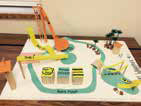
For their end-of-year project, eighth-grade math students at Aledo Middle School in Aledo, Texas build 3D water parks using plastic tubing, blocks, craft foam, and Legos. “Some of them use Cheerios for rafts,” says Keely Carpenter, their teacher. Then they complete a math packet, finding the coordinates of each slide, and so on. Last year, Carpenter used Nepris—a platform that connects STEM professionals with teachers and students—and was connected to a roller-coaster engineer who had done water park work. “He completed our project, answered loads of questions, and showed them his spreadsheets. He kept it at their level and was fantastic.”
Mentor Connections
“Our program is so adaptable and flexible, and all you need to get started is people,” says Darcy Coffta, librarian and director of innovation at Berwick Academy in South Berwick, Maine. She’s talking about the Berwick Innovation Center, a program that pairs students with mentors (on or off campus) to collaborate on projects that include research and a creative element. A student who wanted to do something with the chemistry of baking paired up with an alumni office assistant whose family owns restaurants. Another student, interested in nuclear fission, was mentored by an MIT professor and became one of only 15 students in the world to create a nuclear fusor. “More and more kids are using these projects to differentiate themselves in the college application process,” says Coffta, who is expanding the program to include remote users who can chat online with their mentors. Interested high-school juniors can get details at Berwick Academy’s academics page (www.berwickacademy.org).
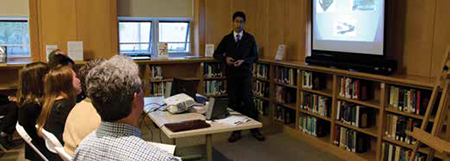
Apps with a Message
When Andrea Chaves, technology teacher at The Young Women’s Leadership School in Astoria, New York, realized that Girls Who Code had room for only 200 girls nationwide, she started her own summer coding program. This past summer, 44 girls spent three weeks learning HTML, CSS, and JavaScript to create apps focusing on recycling, adopting animals, and other social justice issues. They visited Bloomberg Business, Wells Fargo, and other companies to learn about STEM careers. For two weeks each spring, the school cancels regular classes so students can study photography and coding/Web design and produce an eco-friendly fashion show. “The students design clothing out of recycled materials, make videos, and do set design,” says Christy Kingham, an English teacher and technology coach. “We won the Follett Challenge for that project.”
Building Bridges
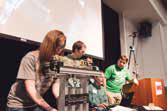
Physics teacher Mark Wechter loves building bridges, and so do his tenth-grade students at Riverdale High School in Portland, Oregon. “For the last 19 years, my students have made bridges out of mass wood sticks and tested them.” Last year, Wechter got to use Vernier’s brand-new Structures & Materials Tester, which was designed specifically for testing bridges. He loves that the new tool does not destroy the bridge like the previous tool did. Every year for the last 11 years, Riverdale High School has sent students to the international bridge-building competition, and half of them have been girls. For the last two years, Riverdale students have placed first.
DIY Computer Science
Kathy Pare enjoyed teaching math but longed to start a computer science department at Junípero Serra High School in San Mateo, California. She did it inexpensively, using free apps and writing her own AP computer science course. Since she launched the department in 2005, the number of students in the program has doubled. “Ninety percent of our students pass the AP computer science test, which is amazing,” says Pare. Recently, she added Oracle Academy’s 12-week online coding course to help students improve their skills. Once students pass the course, they go to a meeting to collaborate with their peers and do practice activities. “A lot of students have told me they love the class and are going to minor in computer science in college. It’s a dream to teach,” she says. The AP class takes an annual field trip; in the past the students have visited companies including Google, Oracle, and DoubleFine Gaming. Pare has also brought in speakers from NASA and Facebook to talk about careers. “Two years ago I couldn’t find people to network with, but now there are tons of resources.”
School Improvement
Jaymes Urban, a seventh-grade science teacher at Bicentennial North in Glendale, Arizona, uses Defined STEM—a Web site with cross-curricular lessons that focus on 21st-century skills—to get ideas and resources. For a sustainability project, Urban’s students researched how other schools became “greener” and designed a brochure describing how their school could do the same. One of their ideas was to plant apple trees in a large, unused playground area to reduce the cost of food for breakfast and lunch. Next, they designed a sustainable building using SketchUp and Blendr. The project culminated with students interviewing a landscape architect in California via Skype.
STEM Contests and Grants
* National Education Foundation: STEM+ Academy grant application and more.
http://www.cyberlearning.org/grantsfunding/1311-2/
* The Lenovo Scholar Network: In partnership with the National Academy Foundation, Lenovo provides the tools and technology for students to create mobile apps.
http://www.lenovoscholars.com/
* Lexus Eco Challenge 2015–2016: A STEM contest for grades 6–12.
http://lexus.scholastic.com
* Global Math Challenge: A worldwide online math competition from Sony Global Education and Edmodo.
https://www.global-math.com
* ExploraVision: Sponsored by Toshiba and administered by the National Science Teachers Association.
http://www.exploravision.org
